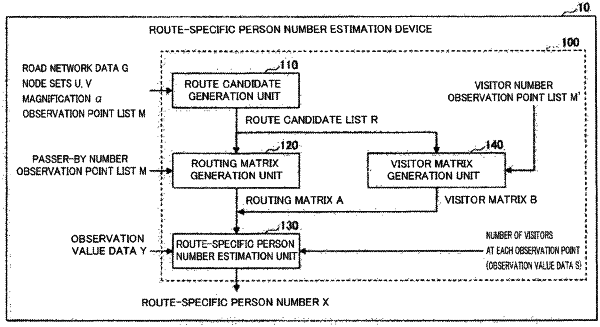| CPC G01C 21/3492 (2013.01) [G01C 21/3691 (2013.01); G08G 1/065 (2013.01)] | 17 Claims |

|
1. A computer-implemented method for estimating a traffic volume of moving objects, the method comprising:
receiving road network data;
generating, based on the received road network data, a plurality of routes from an origin to a destination of one or more of the moving objects;
generating, based on the generated plurality of routes and a first set of observation points for observing a set of traffic volume data of the moving objects, a routing matrix, wherein the routing matrix indicates whether or not the moving object traveling along each of the plurality of routes is observed at each of the first set of observation points;
generating, based on the generated plurality of routes and a second set of observation points for observing a set of visitor volume data of the moving objects, a visitor matrix, wherein the visitor matrix indicates whether or not the moving objects traveling along each of the plurality of routes departs from or arrives at one of the second set of observation points;
receiving the set of traffic volume data of the moving objects observed at each of the first set of observation points;
receiving the set of visitor volume data of the moving objects observed at each of the second set of observation points;
estimating the traffic volume of the moving objects on one or more routes of the plurality of routes based on:
the generated routing matrix,
the generated visitor matrix,
the received set of traffic volume data at the first set of observation points, and
the received set of traffic volume data at the second set of observation point, wherein the estimating further comprises estimating the traffic volume of the moving object by minimizing a sum of:
a first error between the received traffic volume data and the estimated traffic volume data,
a second error between a variation in the visitor volume data and an estimated variation in the visitor volume data, and
a number of the moving objects; and
displaying the estimated traffic volume on a display device.
|